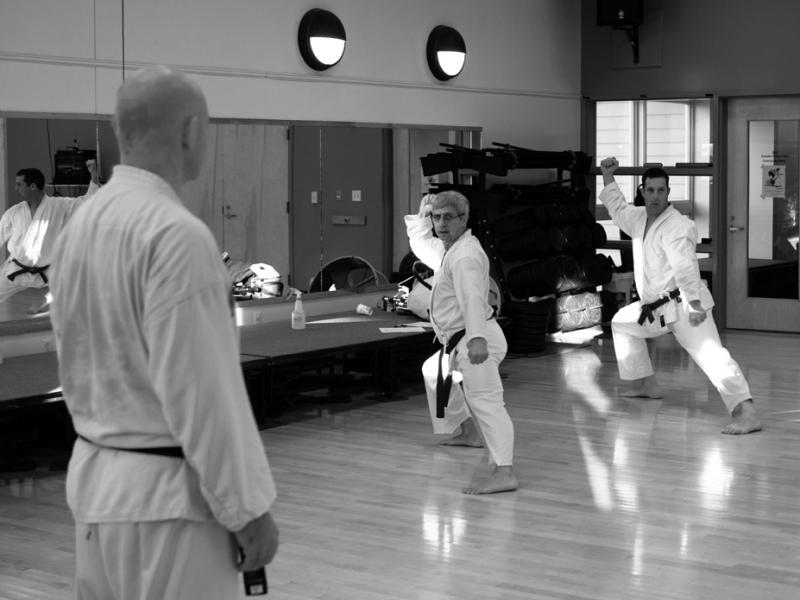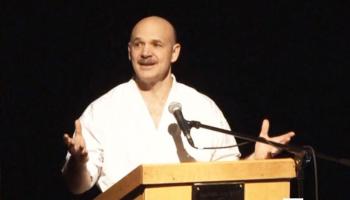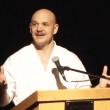Behind the Slides: ‘The Way of Karate’
 David Troup speaking at PechaKucha Night. Screenshot courtesy BC-TV.
David Troup speaking at PechaKucha Night. Screenshot courtesy BC-TV.
 Karatedo: Grandmaster Shoshin Nagamine sitting zazen. (Photo courtesy David Troup.)
Karatedo: Grandmaster Shoshin Nagamine sitting zazen. (Photo courtesy David Troup.)
 The Style: Grandmaster Shoshin Nagamine performing Kusanku Kata as a young man. (Photo courtesy David Troup.)
The Style: Grandmaster Shoshin Nagamine performing Kusanku Kata as a young man. (Photo courtesy David Troup.)
 The Journey: (l to r) Sensei Max Crevani, David Troup, Soke Takayoshi Nagamine, and Sensei Owen Masters in the Upper West Side Dojo. (Photo courtesy David Troup.)
The Journey: (l to r) Sensei Max Crevani, David Troup, Soke Takayoshi Nagamine, and Sensei Owen Masters in the Upper West Side Dojo. (Photo courtesy David Troup.)
 The Training: Students performing Naihanchi Kata at Studio Red. (Photo courtesy David Troup.)
The Training: Students performing Naihanchi Kata at Studio Red. (Photo courtesy David Troup.)
 Mastering A Kata: Students performing Pinan Godan Kata at the Pen Bay YMCA
Mastering A Kata: Students performing Pinan Godan Kata at the Pen Bay YMCA
 The Belts: Promotion testing at the Pen Bay YMCA. (Photo courtesy David Troup.)
The Belts: Promotion testing at the Pen Bay YMCA. (Photo courtesy David Troup.)
 David Troup speaking at PechaKucha Night. Screenshot courtesy BC-TV.
David Troup speaking at PechaKucha Night. Screenshot courtesy BC-TV.
 Karatedo: Grandmaster Shoshin Nagamine sitting zazen. (Photo courtesy David Troup.)
Karatedo: Grandmaster Shoshin Nagamine sitting zazen. (Photo courtesy David Troup.)
 The Style: Grandmaster Shoshin Nagamine performing Kusanku Kata as a young man. (Photo courtesy David Troup.)
The Style: Grandmaster Shoshin Nagamine performing Kusanku Kata as a young man. (Photo courtesy David Troup.)
 The Journey: (l to r) Sensei Max Crevani, David Troup, Soke Takayoshi Nagamine, and Sensei Owen Masters in the Upper West Side Dojo. (Photo courtesy David Troup.)
The Journey: (l to r) Sensei Max Crevani, David Troup, Soke Takayoshi Nagamine, and Sensei Owen Masters in the Upper West Side Dojo. (Photo courtesy David Troup.)
 The Training: Students performing Naihanchi Kata at Studio Red. (Photo courtesy David Troup.)
The Training: Students performing Naihanchi Kata at Studio Red. (Photo courtesy David Troup.)
 Mastering A Kata: Students performing Pinan Godan Kata at the Pen Bay YMCA
Mastering A Kata: Students performing Pinan Godan Kata at the Pen Bay YMCA
 The Belts: Promotion testing at the Pen Bay YMCA. (Photo courtesy David Troup.)
The Belts: Promotion testing at the Pen Bay YMCA. (Photo courtesy David Troup.)
Welcome to our ongoing feature Behind the Slides, where we meet up with an artist who just presented at Pecha Kucha Night and find out the deeper story beneath the images they chose to portray.
David Troup was one of the presenters on the 5th anniversary of PechaKucha Night, held at the Rockport Opera House Jan. 31. Like the other presenters, he took the audience through her creative process in a visual storytelling format with a 20-second-per-image, 20-image slideshow. David Troup has been practicing Karatedo since 1987. He is the communications officer at the Farnsworth Art Museum and is a company member of the Everyman Repertory Theatre. He lives in Rockland with his wife, Hanna.
Note: Troup's Pecha Kucha slides appear in the right column. Click on the photos to match them with the actual slide notes (in italics). Beneath the slide notes will be the deeper story.
Karatedo
Karatedo means The Way of Karate. It’s a path. It’s not a “self-defense technique” that can be learned through books or videos; it must be experienced. It’s a journey, and on that journey, you will be changed.
There are schools that practice Karate, as opposed to Karatedo. The “Do” is the path, or sometimes referred to as “The Way.” My training has led me to continue practicing and teaching not only the actual techniques, but also the philosophies as well. Grandmaster Nagamine felt strongly that Karate and Zen are One. We sit in Zen meditation at the end of class at least two out of three classes.
The Style
The style I practice is called Matsubayashi-Ryu. It was founded by Grandmaster Shoshin Nagamine, one of the true legends of Karatedo, who said “Karate may be described as the conflict within yourself. It is a life-long marathon that can only be won through self-discipline, hard work, and your own creative thinking.”
Grandmaster Nagamine founded the style in 1945 and named it Matsubayashi-ryu to honor the two legendary teachers of his own teachers: Sokon Matsumura and Kosaku Matsumora. It’s a style that is mainly recognizable by the use of what we call Natural Stance. From the great 17th Century Japanese warrior Miyamoto Musashi’s writings: “Your everyday stance must be your fighting stance, and your fighting stance must be your everyday stance.”
The Journey
My own journey with Karatedo began in 1987, when I stopped by Sensei Owen Masters’ dojo on the Upper West Side of Manhattan and began training with him three nights a week. Many years later, I was greatly honored to have Grandmaster Nagamine’s son, Soke Takayoshi Nagamine, come from Okinawa to test me for my first degree black belt.
When I first stopped by the dojo, I was a pretty wild young man. Perhaps Sensei Masters sensed this, but he asked me if I was “serious” about karate, and I said yes, so he told me to come back in a year, and if I was still “serious” I could begin training. When I came back in 1987, he had me sit for three months and just watch, three nights a week. I had the privilege to train with Takayoshi Nagamine, pictured here givingme my first black belt, many times over the years. He died five years ago, as the only 10th degree in the style. I learned from him far more than I could ever write in a paragraph.
The Training
We train our bodies through push-ups, crunches, punches, kicks, applications; but, the most important thing we do is come to class. Sensei Masters always says: “Just get to class, the rest takes care of itself. Like water dripping on a stone, Karatedo will leave its mark.”
Pictured here, some of my students and I are practicing Kata at Studio Red. This picture was taken during a special midnight training, to participate in a world-wide join training session. We were honoring Grandmaster Nagamine’s grandson, who was forced to close his grandfather’s original Dojo in Okinawa and was feeling low. Dojos throughout the U.S., Europe, South American and, of course Japan, participated. 3 p.m. in Okinawa, which was midnight our time. To make things a little more fun, this was the first major snow storm of our season on December 15, 2013!
Mastering A Kata
The essence of what we practice is Kata. There are 18 Kata in our style. A Kata is a choreographed series of applications. This is how Karate was passed from generation to generation. We learn each individual Kata thoroughly, practicing it over and over, forward and reverse, and then we take each individual application out of the Kata and practice it through drills.
It takes a lifetime to master all 18 Kata. Back in the days when Grandmaster Nagamine was a student, a student of Karate knew three, perhaps four, Kata. Now, it’s all about how many you can do. There are schools that teach 50 or so Kata. That’s somewhat of a Westernized way of doing things. When Grandmaster Nagamine visited my Dojo in NYC, he was already in his nineties. He was still practicing the very first Kata—which he actually created back in 1941— as he felt he hadn’t truly mastered it yet.
The Belts
We do have the belt system in my style: White, Green, Brown, Black. Many people think of Black Belt as the equivalent of Expert. Actually, first degree Black Belt is the official rank of the student. We feel that you aren’t truly ready for proper learning and understanding until you reach the rank of Black Belt, which, in our style takes at least five or so years.
Certain schools get somewhat hung-up in the belt system. It’s certainly a motivating feature, especially for kids. My first teacher, Sensei Masters, would never promote anyone until there was a new student in class who needed to be promoted. During the early ‘90s, while I was teaching class for him in our NYC Dojo, he kept me at a Brown Belt level for eight years, as he didn’t see any need to have a promotion ceremony. We do things a little differently now, as I view promotion testing as a great way to test what you’ve learned under somewhat nerve-wracking conditions.
If you missed this Pecha Kucha Night, not to worry. Belfast Community Television has a video of the event. For more information about Pecha Kucha visit them on Facebook.
Kay Stephens can be reached at news@penbaypilot.com
Event Date
Address
United States






































